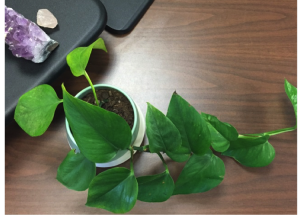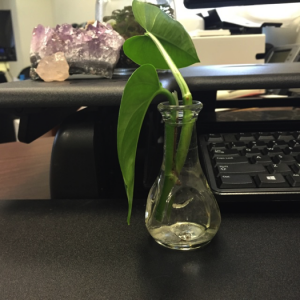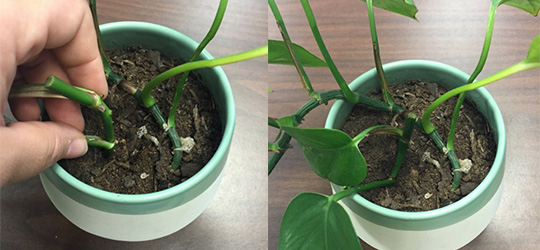
5 Ways to Increase Your Health at Home
Dear Reader,
Our homes are also our temples for restoration of mind, body and spirit.
When you think about it — health truly begins in your home.
You eat, sleep, and spend a majority of your time in this one place.
But what if your home is making you ill?
Chances are it is.
Good indoor air quality is a key factor in creating a healthy home and maintaining a healthy body.
The EPA estimates most people take nine of every 10 breaths indoors. And indoor air has two – five times more pollutants than outdoor air.1
Yikes!
The United Nations Development Program estimated that more than two million people die each year due to the effects of indoor air toxicity. Other studies estimate 14 times as many deaths occur globally from indoor air pollution versus those associated with outdoor air pollution.2
Unfortunately, health-hazardous synthetic fibers, adhesives, paints, pesticides, cleaners, building materials, and personal care products riddle the homes of most Americans, leading to constant exposure.
Logically, these toxins are compromising your lung health.
But, that is not the worst of it. We will get into long-term health effects in a bit.
What are you supposed to do about it?
You can’t throw out everything in your house that contains toxins. If you did, you would be sitting on a concrete slab in the middle of your yard.
Really, you would have to get rid of the house too!
There is one easy, natural, and aesthetic way to decrease pollutants and increase your indoor air quality — in fact, you might have watered one this morning. And four more ways to rid your home of toxins I will share in just a moment.
But first, let me tell you about the toxic culprits hanging out in your abode.
Home Is Where the Harm Is?
Volatile organic compounds (VOCs) make up a majority of indoor pollutants. VOCs are organic chemicals that evaporate at room temperature. Because they evaporate so easily, they can saturate the air in your home quickly.
Common VOCs include benzene, xylene, formaldehyde, tricloroethane, ethylene glycol and acetone — they are in a lot of household items.
Synthetic carpets, paints, adhesives, vinyl flooring, dry wall, particle board, and foam insulation all contain harmful chemicals that emit VOCs.
If this isn’t bad enough, the things we fill our homes with multiply the problem.
Furniture fabrics, cleaners, paper products, plastics, detergents, pharmaceuticals, cosmetics, air fresheners, and automobile exhaust add to the existing VOC levels.
The National Institutes of Health reports:
“Long-term exposure to volatile organic compounds can cause damage to the liver, kidneys, and central nervous system. Short-term exposure to volatile organic compounds can cause eye and respiratory tract irritation, headaches, dizziness, visual disorders, fatigue, loss of coordination, allergic skin reactions, nausea, and memory impairment.”3
What further increases VOC levels — most Americans use HVAC systems to heat and cool their homes. These systems recycle indoor air with little addition of outdoor air, offering little help in reducing the level of VOCs.
In fact, the HVAC systems can help to circulate VOCs in the home.1
And depending on the location of the outside air source, additional VOCs could be coming from outdoors as well.
Car exhaust and industrial emissions are major source of VOCs. If you live adjacent to a highway, parking lot, or industrial site, this increases the level of VOCs entering your home.
VOCs are everywhere. The good news is there are simple ways to lower their levels in your home.
Go Green to Get Clean, Literally
Research done by NASA indicates tropical house plants are effective in removing VOCs from the indoor environment. As tropical house plants emit water through their leaves, air is drawn in to their roots where microbes deactivate and essentially “eat” the harmful chemicals — removing them from your home.4
Also, a study in Environmental Health and Toxicology finds that homes with indoor plants experienced a decrease in levels of VOCs in just a three month period.5
Who knew plants were more than just housewarming gifts destined to be forgotten on an out-of-the-way shelf?
Pothos is a common house plant capable of air purification — it attacks carbon monoxide, formaldehyde and benzene. Placing a pothos near a garage or space close to a road will help decrease VOCs from exhaust.6
It also happens to be very easy to grow.
I have a large Jade pothos in my apartment I propagate regularly to grow “new” plants.
One of these “new” plants resides on my desk at work.

Desk Buddy.
To propagate, the first thing you need to do is find the roots. They are the small nodes at the base of the stem and leaf stalks.

Desk Buddy’s roots.
Next, you will want to find a spot on the vine to cut. Make sure there are at least two leaves in the cutting. Take sharp scissors and cut below the root.

It’s for your own good, Desk Buddy.
Then you will need to place your cutting into a glass container with water. Submerge the root nodes into the water. The roots usually start to grow within a few days. The vine can thrive in water. You can also transplant to soil once roots have sprouted.

“New” Desk Buddy.
You may also plant a cutting directly into soil. This can add more growth to an existing plant or you can create a “new” one.

Desk Buddy makes a friend.
Pothos like indirect sunlight and require watering one-three times a week, depending on soil and indoor temperatures.
Pothos is one of many plants that can improve your air quality. You can find an entire list here.
Here are four more tips to get you started on the road to lower VOCs in your home:
- If you no longer have a use for products containing VOCs, ditch them. Call your local waste management provider and ask them where you can do a hazardous drop off.
- If your products are still in use, be sure to store them in tightly sealed containers in well- ventilated areas — preferably outside as far from your home as possible.
- When you go to buy new products, be sure to read the labels thoroughly. Paints and solvents labelled as having lower VOCs are an obvious choice.
- Consider using natural household cleaners such as vinegar and baking soda, or at very least, buy cleaning products made from all-natural ingredients.
You can remember to the Three Rs when trying to lowering VOCs:
Remove anything not of use.
Reduce exposures.
Replace with natural or “green” products.
Please write in and let me know if you already own or purchase any VOC fighters! nmoore@lfb.org
Live well,

Natalie Moore
Managing editor, Living Well Daily
P.S. Pothos plants are available at most nurseries or at home improvement stores. They are typically less than $10 for a healthy sized plant.
Citations
[1] 10 Tips to Improve Air Quality & Make Indoor Air Safer to Breathe
[2] Houseplants Cut Indoor Ozone
[3]
Volatile Organic Compounds (VOCs)
[4]
Best Houseplants to Improve Indoor Air Quality
[5] Kim H-H, Yang J-Y, Lee J-Y, et al. House-plant placement for indoor air purification and health benefits on asthmatics. Environmental Health and Toxicology. 2014;29:e2014014. doi:10.5620/eht.e2014014.
[6]
Clean-Air Plants for Your Home
[7]
Vitamin D pill a day may improve exercise performance and lower risk of heart disease
Written By Natalie Moore
Natalie Moore is a dedicated health researcher with a passion for finding healthy, natural, and science-based solutions. After a decade of direct healthcare experience in western and natural medicine, she was involved in public health research before joining Living Well Daily.
View More Free Articles
Eat 23 of These Daily to SLASH Heart Risk [DELICIOUS!]
When it comes to heart health, we’re constantly told what we need to cut out. You know the drill—ditch the salt, dump the sugar, and avoid the processed foods. But what if I told you that adding something to your diet could be just as effective for protecting your heart? A comprehensive new scientific analysis...
"Yellow Devil" Fruit CRUSHES Blood Pressure Better Than Meds
I have a confession to make. I hate bananas. Even the smell of them causes my stomach to flip. The funny thing is that I have an uncle and a daughter who are the same—so I wonder if it’s genetic. But even though I consider them the yellow devil of the fruit world, I recommend...
50-Cent Nutrient Puts the Brakes on Aging
Scientists discovered a remarkable “anti-aging” solution hiding in plain sight. It isn’t some exotic compound from a remote rainforest or an expensive laboratory creation. It’s a nutrient you can find at any pharmacy for less than the cost of a cup of coffee. The trouble is, most seniors aren’t getting enough of it, which researchers...
The Hidden Brain Risk Lurking in Your Living Room
If you’re reading this while settled into your favorite chair, you might want to consider standing up… New research uncovered something that might surprise you. Sitting too much can literally shrink your brain. But it gets worse… We all know being sedentary isn’t good for our health. However, researchers at Vanderbilt University uncovered something alarming....
“Biohack” Your Life Like a Billionaire?! Here’s How
You’ve probably seen the headlines about the billionaire who spent millions on “biohacking” to try to make himself younger. He measures hundreds of biomarkers and pops dozens of pills daily. And he’s undergoing experimental treatments that cost more than most folks’ houses. It may have left you wondering if regular people like you and I...
Do THIS Daily to Improve Strength, Flexibility, and Endurance
For any couch potatoes out there… I have some exciting news. If you’ve been avoiding exercise because you hate the gym or don’t have the time, that might be about to change. A groundbreaking study reveals how a few simple moves, done daily in your own home, could dramatically improve your fitness—even if you’ve skipped...
Mailbag: A Post-Prostate Cancer Blueprint for a Better Recovery
“My son just got his prostate removed because of cancer. He is doing well and recovering. My question is there any information you can forward with regards to his lifestyle? Are there things he should not eat, things he should be eating, is social drinking a risk, any vitamins that should be on his list?...
The Stroke-Boosting Threat Lurking in YOUR Arteries
We want to take a moment on this Memorial Day to honor the brave men and women who made the ultimate sacrifice in service to our nation. Their courage, dedication, and selfless commitment to protecting our freedoms will never be forgotten, and their legacy lives on in the country they helped preserve. I’ve warned you...
20-Minute AM Hack Will Revolutionize How You Wake Up
If you feel like you’re in a fog for the first hour after your alarm goes off, you’re not alone. Mornings can be rough. That groggy, disoriented feeling isn’t just annoying—it’s a real physiological phenomenon called “sleep inertia.” And it can drag on for up to two hours after waking, even if you’ve had a...
Weekly Habit QUINTUPLES Your Cancer Risk
Everyone knows that sugar-sweetened sodas aren’t going to win any nutrition awards. That’s not news. But now, a disturbing new study suggests these soft drinks hide a deadly secret. A regular soda habit could do far more damage than just expand your waistline or raise your diabetes risk. The new research reveals these sugary treats...









